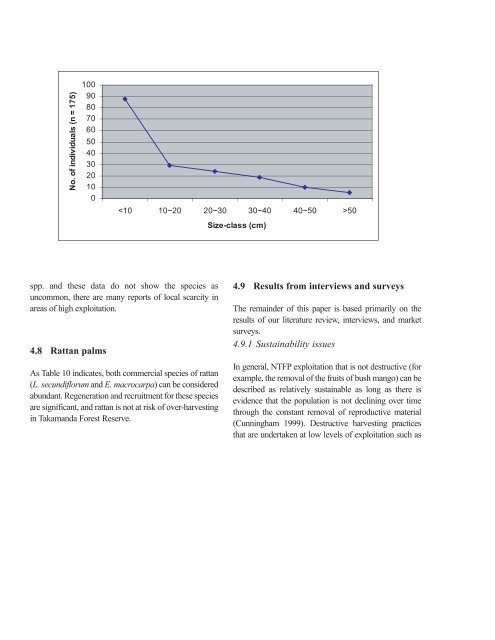Fisheries in the Southern Border Zone of Takamanda - Impact ...
Fisheries in the Southern Border Zone of Takamanda - Impact ...
Fisheries in the Southern Border Zone of Takamanda - Impact ...
You also want an ePaper? Increase the reach of your titles
YUMPU automatically turns print PDFs into web optimized ePapers that Google loves.
No. <strong>of</strong> <strong>in</strong>dividuals (n = 175)<br />
100<br />
90<br />
80<br />
70<br />
60<br />
50<br />
40<br />
30<br />
20<br />
10<br />
0<br />
spp. and <strong>the</strong>se data do not show <strong>the</strong> species as<br />
uncommon, <strong>the</strong>re are many reports <strong>of</strong> local scarcity <strong>in</strong><br />
areas <strong>of</strong> high exploitation.<br />
4.8 Rattan palms<br />
50<br />
As Table 10 <strong>in</strong>dicates, both commercial species <strong>of</strong> rattan<br />
(L. secundiflorum and E. macrocarpa) can be considered<br />
abundant. Regeneration and recruitment for <strong>the</strong>se species<br />
are significant, and rattan is not at risk <strong>of</strong> over-harvest<strong>in</strong>g<br />
<strong>in</strong> <strong>Takamanda</strong> Forest Reserve.<br />
Size-class (cm)<br />
4.9 Results from <strong>in</strong>terviews and surveys<br />
The rema<strong>in</strong>der <strong>of</strong> this paper is based primarily on <strong>the</strong><br />
results <strong>of</strong> our literature review, <strong>in</strong>terviews, and market<br />
surveys.<br />
4.9.1 Susta<strong>in</strong>ability issues<br />
In general, NTFP exploitation that is not destructive (for<br />
example, <strong>the</strong> removal <strong>of</strong> <strong>the</strong> fruits <strong>of</strong> bush mango) can be<br />
described as relatively susta<strong>in</strong>able as long as <strong>the</strong>re is<br />
evidence that <strong>the</strong> population is not decl<strong>in</strong><strong>in</strong>g over time<br />
through <strong>the</strong> constant removal <strong>of</strong> reproductive material<br />
(Cunn<strong>in</strong>gham 1999). Destructive harvest<strong>in</strong>g practices<br />
that are undertaken at low levels <strong>of</strong> exploitation such as

















